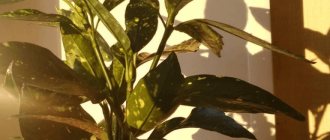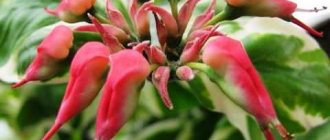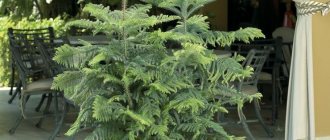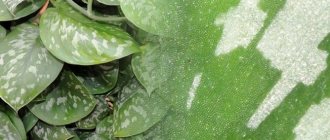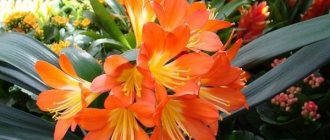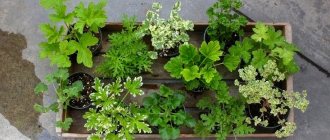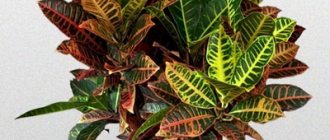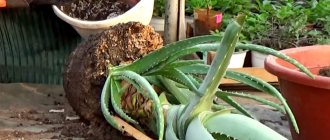Aucuba received the name of the golden tree for its bright yellow spots on the dark green background of the foliage. Because of its thick stem, the plant was called the sausage tree. If you translate the word "aokiba" from Japanese, you get "always green." And the flower really pleases its owners with lush foliage throughout the year. And also long and bright flowering.
This Japanese miracle is perfect for smokers, because it can stay in a smoky room. And it will even purify the air.
Home care
Aucuba will not require special attention to his person. But you still have to create conditions as close as possible to natural ones.
Location and lighting
The sausage tree does not particularly favor bright sunlight. In direct sunlight, the golden-green leaves may fade. But even in the shade the plant will feel bad and stop growing. So, if possible, choose western and eastern window sills. Only varieties with dark green leaf color can be kept away from the window without any problems.
Temperature
A hot climate is absolutely not suitable for aucuba. In summer, she prefers to stay at an air temperature of +18-20°C. In winter it should be even less: +10-14°C. If it is warmer, the flower will shed its leaves.
On late fine days, feel free to take the flowerpot outside. Just choose a place where there is not too much light and protect it from precipitation. During the autumn and winter months, the Japanese plant goes into hibernation and does not produce new leaves. So there is no point in worrying her too much.
Watering
Aucuba tolerates underfilling more easily than overfilling. So, arrange the next replenishment of moisture only when the top layer has time to dry. In hot weather, water the flower about once a week. In autumn and winter, twice a month will be enough.
Do not allow excess moisture in the pot, otherwise the leaves may darken.
Air humidity
As soon as the heating turns on, the golden tree will begin to suffer from dry air. Therefore, during this period, regularly irrigate and wipe the leaves with a damp cloth. If the room is not warm enough, do not overdo it. Otherwise, mold may spread. In spring and summer, the bush does not need moisture.
The soil
To plant aucuba, you need to prepare the soil mixture:
- 25% turf land;
- 25% coarse sand;
- 25% perlite;
- 25% wet peat.
You can safely replace the last component with humus. You need to pour the soil into a pot with drainage holes. Pre-line the bottom with a 3-5 cm layer of expanded clay for drainage.
Feeding and fertilizers
From March to the end of September, regularly feed the sausage tree with mineral fertilizer. Dissolve it in water to the consistency indicated on the package. You cannot add fertilizer to dry soil. Do this only when watering. Starting in October, allow the plant to rest until next spring.
If there are not enough minerals in the soil, the evergreen pet will begin to throw out small leaves.
Transfer
When you bring your aucuba home from the flower shop, immediately replant it in a new location. There is no need to shake off the roots from the substrate; roll them along with the earthen lump. Otherwise, the thin roots may be damaged. Water your new green friend only the next day after transplanting.
If you plant it in a large pot, then replanting will not be needed soon. In a small flowerpot the roots will be cramped and the bush will feel uncomfortable. For the first 5 years, improve the planting conditions for the plant every year. An adult aucuba will not require such actions. Replant as the roots grow.
Trimming
To form a beautiful crown, pinch the tops of the sausage tree annually. This needs to be done in March. And this procedure will have to be repeated every year. At the same time, remove excess shoots. They can be used to obtain new individuals.
Growing Aucuba
Japanese aucuba prefers warmth within the range of +22-23°C; it does not like noticeable temperature fluctuations or drafts. In summer, it can be moved outside to the garden in the shade or to a ventilated balcony. At the same time, the bush must be placed so as not to harm it from sunlight, wind and rain. For wintering, you can find a cooler place with conditions of +10-14°C, but the temperature should not drop below +6°C. Japanese Aucuba flowers and leaves become decorative in shaded lighting. This way its blades better preserve the variegation of the leaf.
Aucuba - soil
In order for healthy evergreen aucuba to grow at home, it is better to plant such indoor flowers in light soil. You can prepare the substrate yourself: mix turf, leaf soil (or humus), moistened peat and coarse sand in equal parts. The container must have a hole and good drainage, otherwise the foliage on the shoots will become covered with brownish spots due to stagnation of liquid.
How to propagate aucuba?
Ornamental deciduous aucuba japonica is propagated by two methods:
- Seeds. At home, high-quality seed can only be obtained if there are two plants of different sexes, otherwise seed embryos will not form in the fruits. On some bushes the flowers have stamens, on others - pistils; the crop must be pollinated manually using a cotton swab. Seeds lose their germination very quickly, so there is no point in storing them.
Freshly harvested grains are soaked for several hours, sown in a wide container with moistened peat and covered with glass. The container is placed in a warm place, the soil is systematically ventilated and moistened. When the sprouts have 3-4 leaves, the covering material can be removed. The sprouts are transplanted into soil consisting of turf soil, humus and sand in a 2:1:1 combination. When propagated by seeds, the variegation of leaves may not be preserved;
By cuttings. This is a faster method of reproduction. The procedure is carried out in February or March. When propagating by cuttings, a shoot with 2-3 leaves is separated from a mature aucuba and placed in a damp peat-sand mixture, covered with cellophane or a plastic bottle. When the seedling has roots, small leaves will grow on it. The strengthened cuttings are planted in a separate vessel with soil made from earth, sand and peat, the tops are immediately pinched so that a thick crown is formed.
Bloom
Even “in captivity,” aucuba from time to time rewards its owners with flowering. Bright yellow-green leaves go well with the red, fiery or red color of the apical inflorescences.
In order for fruits to appear, there must be representatives of male and female plants in the house. Once pollinated, the golden tree bears fruit. They are oblong and red. In appearance they resemble barberry.
Culture transplantation
The flower is planted in a new pot in early spring. This procedure should not be performed more often than once every 5 years. The "Golden Tree" can grow in one pot throughout its life.
The main method is to use the transshipment technique, which will keep the roots intact. A drainage layer consisting of expanded clay, sand or broken brick is placed at the bottom of the prepared container.
The soil should consist of a mixture of soil (necessarily treated against pests), peat and sand. When removing a plant, you must be very careful with the roots, which may be accidentally damaged.
Reproduction
Aucuba can be bred in two ways:
- cuttings;
- seeds.
Use any of them.
Cuttings
Last year's shoots obtained during March pruning are suitable for this method. Make sure that each of them has at least three leaves.
Plant the cuttings in a container with a peat mixture. Stretch plastic film over the top. The sprouts should take root at a temperature of +22°C. Once a week, remove the cover, let the pets ventilate and moisten the soil. When the roots appear, plant the plants in separate flowerpots.
Seeds
Place two pots with a male and female plant next to each other and perform artificial pollination during flowering. When the seeds appear, plant them fresh. After planting in moist peat, set up a mini-greenhouse by covering the container with transparent glass.
Be patient. Aucubes will germinate for a long time and slowly. Keep them warm by occasionally removing the glass, ventilating and watering the planting.
When 2-3 leaves appear on the sprouts, you can pick them. Don't be upset if young plants lose some of the varietal characteristics of their parents. This is quite possible.
Diseases and pests
Like any other plant, the Japanese flower can succumb to malicious attacks. They love to profit from juicy golden leaves:
- aphid;
- scale insect;
- spider mite;
- thrips
If you notice harmful insects, wash the affected bush with soapy water. The scale insect is not afraid of soap, so etch it with alcohol diluted with water. Carry out the treatment three times in a row with an interval of 3-4 days, using insecticides.
Care errors
Despite the fact that it is not capricious, aucuba can suffer from the wrong actions of a novice gardener:
- Yellowing of leaves and dried out tops. They talk about sunburn and the need to move the flowerpot a little further from the window.
- Blackening of leaves. Occurs in two radically opposite cases: excessive humidity or too dry air in the room. Normalize the regime of detention.
- Root rot. It begins to develop if the golden tree is watered too much or it freezes. Do not allow the thermometer to drop below +5°C. Otherwise, it will be almost impossible to save the flower.
- Shredding leaves. Occurs when there is a lack of minerals in the soil. You should urgently feed your evergreen ward.
- Falling leaves. May indicate irregular watering. Get this process going.
- Loss of yellow spots on leaves. This happens if the flowerpot is kept too far from the light. A similar loss of decorativeness can also occur due to a deficiency of nutrients in the soil.
- Slowing growth and thinning shoots. Aucuba needs urgent feeding.
Photo gallery
The culture is unpretentious, but in order to preserve the maximum decorativeness of aucuba, care at home will require compliance with the rules of temperature, humidity, lighting, etc.
Folk signs
The Japanese have long noticed that aucuba has magical properties. This amazing flower helps to improve family relationships. In a house where there is a flowerpot with an evergreen tree, everyone takes care of each other, treats each other with respect and love.
Even guests who find themselves in a warm, friendly atmosphere become more cheerful and kinder. And the negativity brought from outside is immediately blocked by the sausage tree.
Be sure to get yourself a golden bush. This will bring you happiness and wealth. And if the admirer behaves indecisively, not daring to propose, give him a flowerpot with aucuba. He will immediately gain courage, you will get married, and live happily ever after.
Medicinal properties
There was a time that in Japan it was not allowed to export this flower outside the country. After all, the golden tree not only looks beautiful, but has a lot of useful properties. Aucuba leaves can purify the air by destroying harmful bacteria.
In addition, they can be applied to burned, frostbitten, injured areas and hematomas. After keeping the compress for some time, it should be replaced with a fresh one.
Try to strictly follow the recipe, as an overdose can cause harm to the body instead of benefit.
Thermal and chemical wounds can be treated with aucuba fruit. Grind 50 g of fresh raw materials. Apply the resulting pulp onto cotton wool. Bandage it by applying it to the sore spot. The bandage should be changed 3-4 times a day.
Apply 4-5 leaves to the burn, grinding them in a mortar. Apply the paste onto a sterile bandage and apply to the sore spot. You will have to change it every hour.
Since everything about aucuba is poisonous - leaves, flowers and even berries - place the flowerpot as high as possible if there are kids in the house. So that inquisitive family members do not reach out to the golden beauty and cause trouble. Getting juice into the stomach will lead to bad consequences.
Also work with the plant very carefully. After pruning or replanting, wash your hands thoroughly with soap and water.
Kinds
There are eight species of aucuba in total, not counting the many subspecies and varieties. Let's pay attention to the most beautiful representatives of the dogwood family that you can grow at home.
Aucuba japonica
It has smooth oval leaves that can reach 20 cm in length. Sometimes they are decorated with teeth at the end. With good care, this bush will stretch up to 2 m in indoor conditions. And when it blooms, it will delight those around it with bright red panicles.
You are unlikely to expect any fruits from your ward. But if they do appear, they will ripen on white, yellow or red berries. You can shape the crown at your own discretion. But the golden spots on the leaves are always equally located in all representatives of this species.
Aucuba Himalayan
It is found much less frequently among flower growers. This representative has sharp, thin and dark green leaves with seemingly cut edges. The shoots develop quite quickly, so the pet requires regular pruning. Golden spots on leaf blades can be either large or small. And some varieties do not have them at all.
Be sure to pay attention to this marvelous ornamental plant, which will delight you not only with beautiful bright flowers, but also with unusually colorful leaves with golden splashes.
Aucuba japonica
Japanese aucuba - Aucuba japonica Thunb. - an evergreen shrub up to 4-5 m tall from the dogwood family (Corpaceae). The leaves are opposite, oval or ovate, large-serrate along the edges, shiny. The flowers are small, inconspicuous, in paniculate inflorescences. The fruits are berry-shaped, scarlet, less often yellow or white. Homeland - humid subtropics of Japan. In cultivation, the garden form with marbled yellow spots on the leaves is more common. The features of agricultural technology are the same as for the previous type.
Back in 1783, Aucuba japonica was first introduced to Europe. Then, thanks to its high decorative value, as well as the ease of propagation by both seeds and shards, it quickly and widely spread in cultivation in the open ground (in Russia - in the Caucasus since the 80s of the 19th century), and became a favorite in indoor and greenhouse gardens. culture, and in a significant number of cultural forms. Particularly original are the forms with leaves decorated either with small or larger yellowish spots, giving the leaf a resemblance to a sample of gold-bearing rock or... to a slice of sausage, from which, obviously, the popular names of aucuba “golden tree” and “sausage tree” originated.
Leaves of Aucuba species turn black when they die and dry. Aucuba japonica was one of three plants on which the German physiologist G. Molischw discovered in 1931 the effect of “rings of death” - the formation of black rings on the leaf around the places to which a heated glass tube was brought. Later it was found that both this affect and the blackening of dying leaves are due to the breakdown of the iridoid glycoside aucubin, characteristic of aucuba leaves, which, by the way, has a medicinal property - the ability to increase the acidity of gastric juice.
Studying the phytoncidal properties of greenhouse plants, S. Yu. Turdiev and D. T. Volkov (1966) described 45 species with bactericidal and protistocidal properties. L.V. Azarova (1974) also confirmed the phytoncidal activity of a number of greenhouse plants. They studied the phytoncidal activity of over 100 plant species from the range recommended for landscaping industrial interiors. Many succulents, such as aloe, milkweed, crassula and kalanchoe, also have antimicrobial activity. Academician A. M. Grodzinsky, speaking at the 8th All-Union Meeting on Phytoncides, emphasized the need for a thorough development of the theory of phytoncides in close connection with the theory of phytodesign. He proposed to call phytodesign the introduction of plants into ergonomic systems (closed complexes: man - machine - environment) and consider this activity as part of the overall design, performing aesthetic, sanitary, environmental and other functions.
